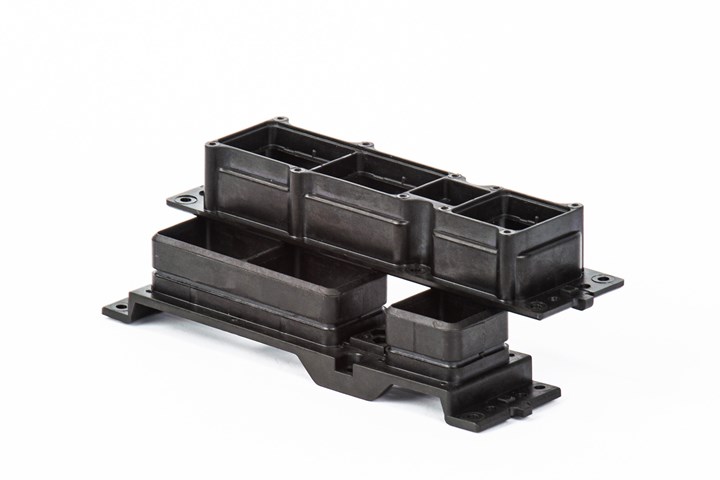HX5 thermoplastic nanocomposite demonstrates electromagnetic shielding properties
Certified for use from rockets and satellites to amphibious transport vehicles, EMI testing indicates exceptional attenuation when bare or plated for shielding effectiveness.
Share

Photo Credit: Alpine Advanced Materials
Alpine Advanced Materials (Dallas, Texas, U.S.) reported in October that it has completed Electromagnetic Interference (EMI) testing on HX5 — a lightweight military aviation grade thermoplastic nanocomposite material — and found it to have exceptional attenuation when bare or plated with various thicknesses of nickel and copper. The highly engineered HX5 has already demonstrated its strength and performance for use in complex components, says the company, but the results of the EMI testing indicate that it is an even more attractive material for use in electronics.
EMI, which is caused by an electronic device sending radio frequency or electromagnetic waves to another device, can disrupt electronic devices, equipment and systems used in critical medical, military, aerospace, mass transit, vehicular control and navigation systems. Shielding blocks electromagnetic fields, ensuring reliable system performance, a feature that the EMI testing discovered the HX5 material possessed.
“The results of our EMI testing were pleasantly surprising because thermoplastics usually have minimal attenuation,” says Roger Raley, president of Alpine Advanced Materials. “High attenuation means parts made with HX5 prevent varying radio and electronic frequencies from interfering with each other. We know how strong HX5 is, but these findings add to the body of evidence on its superior handling.”
Two independent labs tested both coated and bare HX5 to investigate the relationship between film thickness and attenuation for a range of frequencies from 10 kilohertz (kHz) to 40 gighertz (GHz). Testing specifications used included IEEE 299-2006, MIL-STD-285.
“We found that HX5 can be plated for EMI shielding at a range of 12kHZ to 40GHz, and secured data for electrical surface and volume resistivity for bare and plated HX5, confirming both electroless plating for EMI shielding and shielding effectiveness,” adds Marinela Peto, Mechanical Engineer for Alpine Advanced Materials. “In fact, test results showed comparable and even higher attenuation levels for bare HX5 versus plated samples for certain frequencies from 12GHz to 40GHz.”
With a high strength-to-weight ratio, thermal stability, environmental resistance and manufacturing flexibility, HX5 can be injection molded, formed, extruded or machined like aluminum. It allows component manufacturers to make complex shapes with a specific strength (ratio of tensile strength divided by density) twice that of aluminum on a weight to weight basis.
Developed for more more than a decade via testing and validation by the Department of Defense with an R&D investment in excess of $50 million, Alpine Advanced Materials says HX5 was engineered to replace machined aerospace-grade aluminum at half the weight. Earlier this year, it was shown in third-party testing to retain up to 96% of its original mechanical performance when subjected to 5 million rads of gamma radiation. It has also demonstrated extreme corrosion resistance to solvents, fuels, lubricants and chemicals, giving it the ability to withstand the most demanding applications. Already certified for use from rockets and satellites to amphibious transport vehicles, HX5 is an ideal alternative to aluminum at half the weight and multiple times the manufacturability.
Related Content
-
Manufacturing the MFFD thermoplastic composite fuselage
Demonstrator’s upper, lower shells and assembly prove materials and new processes for lighter, cheaper and more sustainable high-rate future aircraft.
-
Combining multifunctional thermoplastic composites, additive manufacturing for next-gen airframe structures
The DOMMINIO project combines AFP with 3D printed gyroid cores, embedded SHM sensors and smart materials for induction-driven disassembly of parts at end of life.
-
Welding is not bonding
Discussion of the issues in our understanding of thermoplastic composite welded structures and certification of the latest materials and welding technologies for future airframes.















